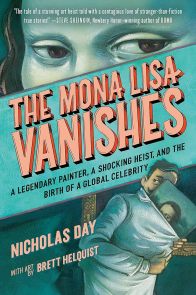 No One Leaves the Castle by Christopher Healy, 2023
No One Leaves the Castle by Christopher Healy, 2023
Recommended for grades 4-8
Fantasy, Mystery
Brief Review
The Lilac, a fourteen-year-old aspiring bounty hunter, has just landed her first contract with the help of her partner, a rookie bard who goes by Dulcinetta the Dulcet-Toned, or Netta for short. Her job is to apprehend the wizard Runar the Unknowable, who has “absconded with the Emerald Axe of Angbar.” Except he didn’t do it. The baron has accused him due to an elitist prejudice against magicians. Later that evening, Runar is murdered at Castle Angbar. The Lilac finds herself in the role of detective, investigating both the theft of the axe and the wizard’s murder. Just before his death, Runar cast a spell, surrounding the castle in a bubble that keeps all the suspects trapped together inside. As the Lilac and Netta interview the Baron, his wife and two children, their four staff members, and their guest, Baron Garridan, she uncovers dark secrets about each of them, but she seems to be making little progress in solving the double mystery or figuring out how to dispel Runar’s bubble, which now threatens to crush the castle. Each of the characters has a distinctive personality and complex backstory, and the continual silly banter will appeal to a preteen reader’s sense of humor without distracting from the elaborate plot and atmospheric medieval-fantasy setting. Strongly recommended for most middle grade readers and potentially teens and adults also.
Longer Review
The Emerald Axe of Angbar has been stolen, and the baron’s butler, Gribbinsnood Flornt, has been sent to procure a bounty hunter. This task is outside of his comfort zone, so he follows the first recommendation he hears. Based on a song performed by the young bard Dulcinetta the Dulcet-Toned, he hires a bounty hunter known as the Lilac. Only after signing the contract does Flornt discover that the Lilac is, in fact, a fourteen-year-old girl who is just starting her career, and that she and the bard, who generally goes by the nickname Netta, are business partners.
Surprisingly, the Lilac quickly succeeds at apprehending the suspect, the wizard Runar the Unknowable. (Despite his name, Runar is not unknowable; he’s actually very famous) But Runar does not have the Emerald Axe in his possession. He tells his captors that the Baron Angbar hates magicians and especially hates him, since he is tutoring the Baron’s son. For the purpose of fulfilling her first bounty hunting contract, the Lilac and Netta travel with Flornt back to Castle Angbar to turn in the suspect. But when they arrive, it turns out that the Emerald Axe is in its display case. The contract specifies that the Lilac was to catch “the individual who absconded with the Emerald Axe of Angbar,” and since Runar did not steal the axe, the baron concludes that he doesn’t owe the Lilac any payment.
For the sake of etiquette, Baroness Hecatina invites the Lilac and Netta to stay for dinner. They are already hosting Baron Garridan. Along the way, the girls have also met the Baron’s children Araminta and Kade, as well as Chef Penumbra, the children’s etiquette teacher Madame Hofflig, and the guard, an ogre named Grymus. During the dinner party, Flornt discovers that the Emerald Axe has gone missing for real. Runar is accused again, and he decides it’s time to “[put] an end to this.” He casts a spell that surrounds the castle in a bubble, trapping the twelve characters inside together. Since he has come to respect the Lilac’s skill as a bounty hunter, he assigns her to solve the mystery.
The mystery quickly thickens. After the Lilac sends each suspect to separate rooms and begins the process of interrogating everyone individually, Runar is found dead. As the Lilac continues questioning everyone and investigating both the theft and the mystery, she uncovers secrets about every single resident, staff member, and guest in the castle. And she has her own secret, which some of her new acquaintances are figuring out at the same time. Meanwhile, Runar’s magical bubble around the castle is slowly closing in. In order to undo the spell, the Lilac must locate a page that was torn from Runar’s spellbook.
An endorsement from author Adam Gidwitz describes this book as “if Agatha Christie ran the funniest D&D campaign in the world,” and I think that’s an apt description. Each of the characters is as complex and distinctive as if he or she had been created by a different D&D player, and the continual silly banter will appeal to a preteen reader’s sense of humor without detracting from the elaborate plot, full of surprising revelations about each character’s shady backstory. Recommended for most middle grade readers and potentially teens and adults also, because this story will appeal to anyone who likes fantasy medieval settings, complex mysteries, or comedic dialogue. I highly recommend reading this book in a relatively short time frame since there are so many small details that end up being important later in the story.
 The Mona Lisa Vanishes by Nicholas Day, illustrated by Brett Helquist, 2023
The Mona Lisa Vanishes by Nicholas Day, illustrated by Brett Helquist, 2023 No One Leaves the Castle
No One Leaves the Castle